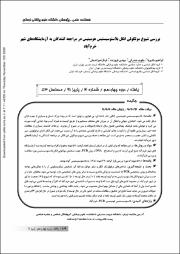| dc.identifier.citation | Badparva, ebrahim, Sadraei, javid, Frozandeh, mehdi, Khirandish, farnaz. (2012). A molecular prevalence of Blastocystis hominis in patients referred to medical diagnosis laboratories in Khorramabad city. scientific magazine yafte, 14(4), 107-112. | en_US |
| dc.description.abstract | Background : Blastocystis hominis is an anaerobic, zoonotic protozoan parasite which inhabits the large intestine of humans and a wide range of other vertebrates. It has a worldwide distribution and infects hosts through the cyst of the parasite by contaminated water or food. Its prevalence is related to hygienic culture, season, exposure to animals, and age. A number of studies in the last decade have confirmed its potential pathogenicity, and many gastrointestinal and extra-gastrointestinal signs have been attributed to it. It has unique morphology, life cycle, and reproduction. The aim of this research is to study molecular prevalence of this parasite in the patients referred to Khorramabad laboratories.
Materials and Methods: In this study, conducted for the first time in Lorestan province, 511 stool samples were collected from patients in laboratories of Khorramabad. After DNA was extracted using PCR, the samples were examined for the existence of Blastocystis parasite.
Results: Out of the 511 samples studied, 33 ones (6.5%) were infected with Blastocystis.
Conclusion: The microscopic diagnosis is challenged by morphological characteristics and other intervening factors, and the PCR method, which has higher sensitivity and specification than other diagnostic methods, is recommended. Concerning the prevalence of the parasite, the world has been divided into two parts of developed and developing countries by the researchers, with 10% and 50% prevalence rates respectively. The 6.5% prevalence in the cited population in Khorramabad is in the range of the prevalence in the developed countries. Therefore, the result is justifiable since springs provide most of the drinking water in the region. However, since ranching is a popular occupation in the region, the prevalence rate is alarming. Therefore, following health instructions and appropriate clothing when exposing to livestock are recommended. In addition, the results of this study and similar studies in the developing countries, on the one hand, and the increasing prevalence of 23% in the US as a developed country, on the other hand, have disturbed the previous division. | en_US |





